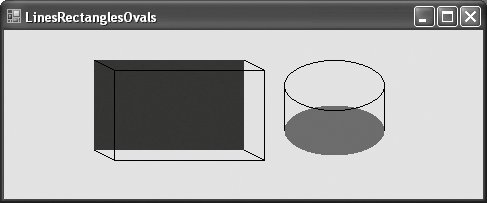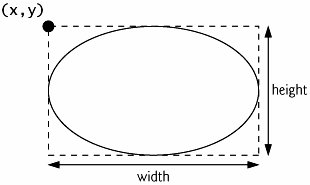Section 17.6. Drawing Lines, Rectangles and Ovals
17.6. Drawing Lines, Rectangles and OvalsThis section presents Graphics methods for drawing lines, rectangles and ovals. Each of the drawing methods has several overloaded versions. Methods that draw hollow shapes typically require as arguments a Pen and four ints. Methods that draw solid shapes typically require as arguments a Brush and four ints. The first two Integer arguments represent the coordinates of the upper-left corner of the shape (or its enclosing area), and the last two ints indicate the shape's (or enclosing area's) width and height. Figure 17.13 summarizes several Graphics methods and their parameters. [Note: Many of these methods are overloadedconsult the online Graphics class documentation for a complete listing (msdn2.microsoft.com/en-us/library/system.drawing.graphics).] Figure 17.13. Graphics methods that draw lines, rectangles and ovals.
The application in Fig. 17.14 draws lines, rectangles and ellipses. In this application, we also demonstrate methods that draw filled and unfilled shapes. Figure 17.14. Demonstration of methods that draw lines, rectangles and ellipses.
Methods FillRectangle and DrawRectangle (lines 12 and 21) draw rectangles on the screen. For each method, the first argument specifies the drawing object to use. The FillRectangle method uses a Brush object (in this case, an instance of SolidBrusha class that derives from Brush), whereas the DrawRectangle method uses a Pen object. The next two arguments specify the coordinates of the upper-left corner of the bounding rectangle, which represents the area in which the rectangle will be drawn. The fourth and fifth arguments specify the rectangle's width and height. Method DrawLine (lines 1518) takes a Pen and two pairs of ints, specifying the start and end of a line. The method then draws a line, using the Pen object. Methods FillEllipse and DrawEllipse (lines 27 and 34) each provide overloaded versions that take five arguments. In both methods, the first argument specifies the drawing object to use. The next two arguments specify the upper-left coordinates of the bounding rectangle representing the area in which the ellipse will be drawn. The last two arguments specify the bounding rectangle's width and height, respectively. Figure 17.15 depicts an ellipse bounded by a rectangle. The ellipse touches the midpoint of each of the four sides of the bounding rectangle. The bounding rectangle is not displayed on the screen. Figure 17.15. Ellipse bounded by a rectangle. |
EAN: 2147483647
Pages: 435

